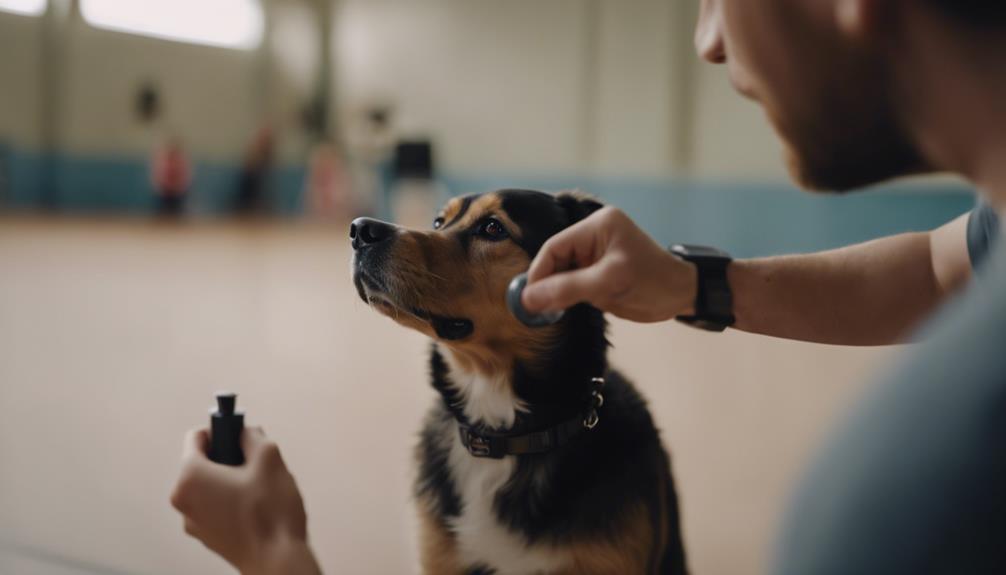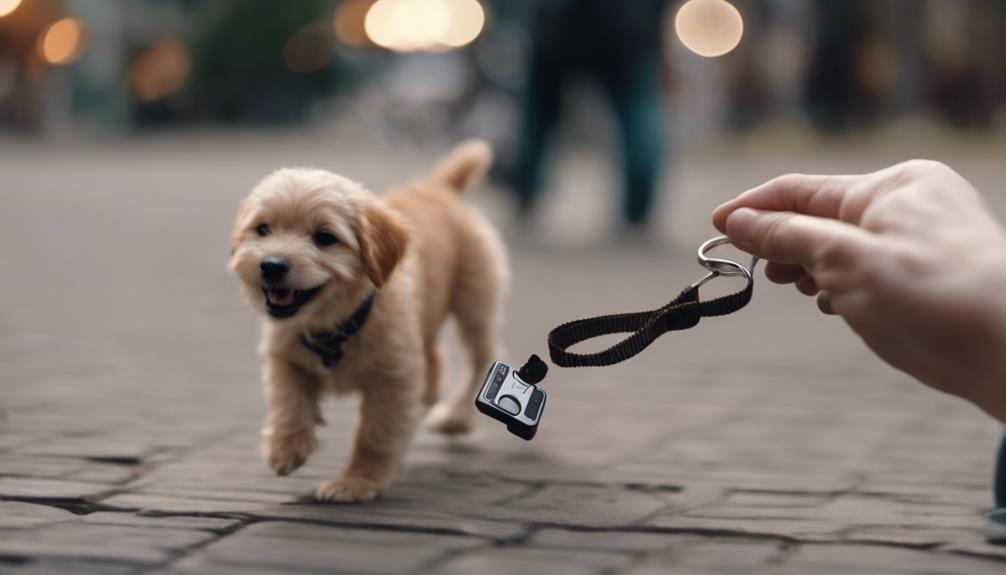If you've ever wondered about the secret behind effective training methods for your furry friend, markers hold the key to unlocking a new level of communication and understanding with your pet.
The power of a subtle signal in shaping behaviors is undeniable, but the true magic lies in how markers can transform your training sessions.
As you explore the world of markers in training, you'll uncover a wealth of benefits and insights that could revolutionize your approach to teaching your pet.
Stay tuned to discover the untapped potential of markers and why they might just be the missing piece in your training toolkit.
Key Takeaways
- A marker in training signals the exact moment a behavior is correct.
- Markers enhance communication and efficiency in teaching pets.
- Markers are not cues but aid in positive reinforcement and behavior shaping.
- Pairing a strong reinforcer with a marker is crucial for effective training.
Importance of Markers in Training
If you're looking to enhance your training sessions with your pet, understanding the importance of markers is key. Markers serve as precise communication tools, signaling to your pet the exact moment they exhibit a desired behavior. By using markers effectively, you can bridge the communication gap between you and your furry friend.
This clarity helps your pet associate the behavior with the impending reward, facilitating quicker learning and reinforcing positive actions. Markers streamline the training process, making it more efficient and enjoyable for both you and your pet.
Understanding Marker Vs. Cue
Markers and cues serve distinct purposes in training your pet, each playing a crucial role in facilitating effective communication and learning. While markers indicate the exact moment a behavior earns a reward, cues prompt your pet to perform a specific action. Understanding the difference between these two is essential for successful training. Here are some key points to differentiate between markers and cues:
- Markers signal the correct behavior.
- Cues instruct your pet on what behavior to perform.
- Markers are followed by a reward.
- Cues precede the desired behavior.
- Markers mark the precise moment of success.
Benefits of Marker Training

Enhance your pet training experience with the myriad benefits of marker training. Markers enhance communication between you and your pet, making the teaching process more efficient and enjoyable.
By using markers, you can simplify complex behaviors, reinforce desired actions, and create a clear association between behavior and reward. This method not only helps in teaching basic commands like sit or stay but also enables you to explore the versatility of marker training for various tricks.
Effective Positive Reinforcement Techniques
To effectively reinforce positive behaviors during training, focus on pairing a strong reinforcer with a distinct marker. This combination helps your pet understand exactly which behaviors are earning them a reward.
Here are five effective positive reinforcement techniques to enhance your training sessions:
- Use high-value treats or rewards that your pet loves.
- Consistently apply the marker immediately after the desired behavior.
- Keep training sessions short and engaging to maintain focus.
- Vary the rewards to keep your pet motivated and interested.
- Celebrate small successes to build confidence and reinforce learning.
Practical Applications of Markers

For effective training results, incorporate markers into your pet's learning routine. Markers serve as precise signals to indicate the exact behavior that led to a reward, making learning more efficient and enjoyable for both you and your pet. By consistently using markers, you can reinforce desired behaviors, teach new tricks, and ensure clear communication during training sessions. See the table below for practical applications of markers:
| Practical Applications of Markers | |
|---|---|
| Teach basic commands | Reinforce behaviors |
| such as sit or stay | Teach new tricks |
| Ensure enjoyable training sessions | Explore versatility |
Enhancing Communication With Markers
Improving communication with your pet through marker training involves establishing clear signals for desired behaviors. By using markers effectively, you can enhance your connection with your furry friend and make training more efficient.
To maximize communication with markers, consider the following tips:
- Consistently use the same marker for specific behaviors.
- Practice timing to ensure the marker is given immediately after the desired action.
- Keep your markers distinct to avoid confusion.
- Use positive reinforcement along with markers to reinforce good behavior.
- Remember to stay patient and consistent in your training approach.
Key Roles of Markers in Learning

Markers play a crucial role in facilitating efficient communication and reinforcement during pet training sessions. By providing a clear signal at the precise moment a desired behavior occurs, markers help your pet understand which actions lead to rewards. This instant feedback reinforces the behavior, making it more likely to be repeated.
Through markers, you can effectively communicate with your pet without relying solely on verbal commands, creating a common language that enhances the learning process. Additionally, markers serve as a bridge between the behavior and the reward, strengthening the association between the two.
Incorporating markers into your training routine can significantly improve the speed and effectiveness of teaching new behaviors to your pet.
Maximizing Training Efficiency With Markers
To enhance the efficiency of your training sessions with markers, focus on precise timing and consistent feedback to reinforce desired behaviors effectively. Utilize these tips to make the most of your marker training:
- Timing is Key: Mark the exact moment the desired behavior is displayed.
- Consistency Matters: Ensure your marker is always followed by a reward.
- Clear Communication: Use a distinct sound or signal as your marker.
- Practice Regularly: Engage in short but frequent training sessions.
- Celebrate Small Wins: Mark and reward incremental progress to maintain motivation.
Marker Training for Behavior Modification

For effective behavior modification, implementing marker training can significantly enhance your pet's learning experience and promote positive changes in their actions. By using markers to reinforce desired behaviors and discourage unwanted ones, you can effectively shape your pet's conduct. Check out the table below for a clearer understanding of how marker training can aid in behavior modification:
| Benefits of Marker Training for Behavior Modification | How It Helps | Examples |
|---|---|---|
| Increases clarity in communication between you and your pet | Ensures your pet understands which behaviors are being rewarded | Using a clicker to signal the correct action |
| Reinforces positive behaviors consistently | Encourages your pet to repeat desirable actions | Giving treats immediately after the marker for good behavior |
| Facilitates quicker learning of new behaviors | Speeds up the training process for teaching new commands | Teaching your pet to retrieve specific items using markers |
Tips for Successful Marker Training
For successful marker training, ensure your pet is in a quiet, distraction-free environment conducive to learning. To make the most of your marker training experience, follow these tips:
- Choose the Right Marker: Select a clicker or a verbal cue that your pet responds to effectively.
- Timing is Key: Click or say the marker just before presenting the treat to reinforce the behavior.
- Be Consistent: Maintain quick but clear timing to ensure effective communication.
- Practice Makes Perfect: Apply the marker consistently across different training commands to avoid confusion.
- Keep It Enjoyable: Make sure training sessions are fun and engaging for both you and your pet to foster a positive learning environment.
Conclusion
In conclusion, using markers in training can greatly enhance your communication with your furry companion. By providing clear signals for desired behaviors, markers make learning more efficient and enjoyable for both you and your pet.
With the right techniques and consistency, marker training can strengthen the bond between you and your four-legged friend while achieving desired training outcomes.
So why not give it a try and see the positive impact markers can have on your training sessions!




